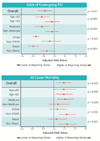Association between public reporting of outcomes with procedural management and mortality for patients with acute myocardial infarction
- PMID: 25790884
- PMCID: PMC4368858
- DOI: 10.1016/j.jacc.2015.01.008
Association between public reporting of outcomes with procedural management and mortality for patients with acute myocardial infarction
Abstract
Background: Public reporting of procedural outcomes may create disincentives to provide percutaneous coronary intervention (PCI) for critically ill patients.
Objectives: This study evaluated the association between public reporting with procedural management and outcomes among patients with acute myocardial infarction (AMI).
Methods: Using the Nationwide Inpatient Sample, we identified all patients with a primary diagnosis of AMI in states with public reporting (Massachusetts and New York) and regionally comparable states without public reporting (Connecticut, Maine, Maryland, New Hampshire, Rhode Island, and Vermont) between 2005 and 2011. Procedural management and in-hospital outcomes were stratified by public reporting.
Results: Among 84,121 patients hospitalized with AMI, 57,629 (69%) underwent treatment in a public reporting state. After multivariate adjustment, percutaneous revascularization was performed less often in public reporting states than in nonreporting states (odds ratio [OR]: 0.81, 95% confidence interval [CI]: 0.67 to 0.96), especially among older patients (OR: 0.75, 95% CI: 0.62 to 0.91), those with Medicare insurance (OR: 0.75, 95% CI: 0.62 to 0.91), and those presenting with ST-segment elevation myocardial infarction (OR: 0.63, 95% CI: 0.56 to 0.71) or concomitant cardiac arrest or cardiogenic shock (OR: 0.58, 95% CI: 0.47 to 0.70). Overall, patients with AMI in public reporting states had higher adjusted in-hospital mortality rates (OR: 1.21, 95% CI: 1.06 to 1.37) than those in nonreporting states. This was observed predominantly in patients who did not receive percutaneous revascularization in public reporting states (adjusted OR: 1.30, 95% CI: 1.13 to 1.50), whereas those undergoing the procedure had lower mortality (OR: 0.71, 95% CI: 0.62 to 0.83).
Conclusions: Public reporting is associated with reduced percutaneous revascularization and increased in-hospital mortality among patients with AMI, particularly among patients not selected for PCI.
Keywords: acute coronary syndromes(s); percutaneous coronary intervention; public reporting.
Copyright © 2015 American College of Cardiology Foundation. Published by Elsevier Inc. All rights reserved.
Figures


Comment in
-
Public reporting of percutaneous coronary intervention outcomes: harm or benefit?J Am Coll Cardiol. 2015 Mar 24;65(11):1127-9. doi: 10.1016/j.jacc.2015.01.034. J Am Coll Cardiol. 2015. PMID: 25790885 No abstract available.
References
-
- Kushner FG, Hand M, Smith SC, Jr, et al. 2009 focused updates: ACC/AHA guidelines for the management of patients with ST-elevation myocardial infarction (updating the 2004 guideline and 2007 focused update) and ACC/AHA/SCAI guidelines on percutaneous coronary intervention (updating the 2005 guideline and 2007 focused update) a report of the American College of Cardiology Foundation/American Heart Association Task Force on Practice Guidelines. J Am Coll Cardiol. 2009;54:2205–2241. - PubMed
-
- Wright RS, Anderson JL, Adams CD, et al. 2011 ACCF/AHA Focused Update of the Guidelines for the Management of Patients With Unstable Angina/ Non-ST-Elevation Myocardial Infarction (Updating the 2007 Guideline): a report of the American College of Cardiology Foundation/American Heart Association Task Force on Practice Guidelines. Circulation. 2011;123:2022–2060. - PubMed
-
- Ritley D, Romano p. The State of Cardiac Revascularization Outcomes Reporting. 2011
-
- Hannan EL, Kilburn H, Racz M, Shields E, Chassin MR. Improving the outcomes of coronary artery bypass surgery in New York State. JAMA. 1994;271:761–766. - PubMed
-
- Burack JH, Impellizzeri P, Homel P, Cunningham JN., Jr Public reporting of surgical mortality: a survey of New York State cardiothoracic surgeons. Ann. Thorac. Surg. 1999;68:1195–1200. discussion 1201–1202. - PubMed
Publication types
MeSH terms
Grants and funding
LinkOut - more resources
Full Text Sources
Other Literature Sources
Medical
Miscellaneous

